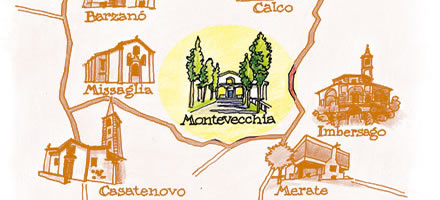Day 1 – Montevecchia
Visit to the Beata Vergine del Carmelo Sanctuary
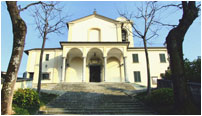 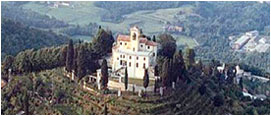
Astronomical observatory: The observatory is a unique location both inside and outside the sphere of cultural sites visitors can tour in the Province of Lecco. From the stunning cupolas in the northernmost part of Merate set atop a beautiful hill, it is possible to observe the star-studded skies through the powerful telescopes placed at the disposal of visitors. The observatory is also an important centre for data processing and research. It opens on the first Friday (apart from bank holidays) of each month, with four guided visits throughout the course of the day at 9:30, 10:30, 14:30, 15:30. It also opens two nights a month by prior booking.
The Wine Museum (at Cascina Casarigo): from 14:00 to 18:00 by prior booking only.
Cascina Cà Soldato Parl (open Saturday and Sunday): visitors can observe the fauna in the park and its various types of habitat.
Maggioni Amabile Dairy:local dairy produce specialities (via Alta Collina, 27 – Montevecchia – Tel: 039-9930982).
Imbersago: it is possible to visit the Madonna del Bosco Sanctuary and Da Vinci’s ferry boat at the Ecomuseo Adda. It is also possible to follow a nature trail along the Adda River or the cycle path from Olginate to Imbersago (15 km).
Day 2– Visit to the town of Lecco |
Villa Manzoni:open from Tuesday to Sunday from 09:30 to 17:30.
Palazzo Belgiojoso: includes the Natural History Museum and the Archaeological Museum; open from Tuesday to Sunday from 09:30 to 14:00.
Visconti Tower: includes the Mountain Museum (open to CAI- the Italian Alpine Club- members by appointment (tel: +039 0341.363588;) Tuesday and Friday 20:00 to 22:30).
Manzoni Itinerary: tour of the places featured in the novel “the Betrothed” by Alessandro Manzoni. The tour starts out from Pescarenico and finishes in Vercurago. During the tour it is possible to see the convent of Father Cristoforo, The Church of Saints Materno and Lucia, Lucia’s house, Don Rodrigo’s court, and the Castle of the Unnamed. |
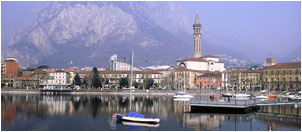 |
|
Historical tour of the old town centre: tour of the alleys in the city centre during which it will be possible to see the remains of the walls and gates into the town, the Basilica of San Nicolò, the Church of Santa Marta and the Teatro Sociale theatre.
|
Lakeside tour:
- Abbadia Lariana: “Monti” Silk Museum (open Sundays and holidays from 10:00 to 12:00 and 14:00 to 18:00. On weekdays it is only open by prior appointment, which should be made with the Municipality of Abbadia and the Library).
- Mandello: Church of San Giorgio (open Saturday 14:00 to 18:00; Sundays and public holidays from 10:00 to 12:00 and 14:00 to 18:00); Moto Guzzi Museum (open every afternoon from 15:00 to 16:00; Saturday guided visits by appointment).
|
- Varenna: the gardens and rooms of Villa Monastero and Villa Cipressi; (Villa Monastero and Villa Cipressi: the gardens are open from 31 March to 1 November from 09:00 to 19:00; the Museum House of Villa Monastero can be visited on Saturdays from 13:00 to 17:00 and every Sunday and public holidays 10:00 to 13:00 and 14:00 to 18:00. The “Lovers’ Path”; the castle of Vezio (from April to October every day from 10:00 to sunset); the seventeenth-century churches of Santa Marta and Santa Maria delle Grazie; the Ornithological Museum (from April to July, Saturday and Sunday from 10:30 to 12:30 and 15:30 to 18:30; in August open every day from 10:30 to 12:30 and 15:30 to 17:30).
|
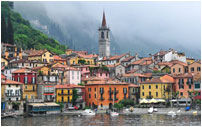
|
|
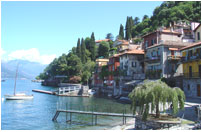 |
Bellano: The Gorge (Open all year: from 1 April to 30 September every day from 10:00 to 13:00 and from 14:30 to 19:00; July and August also open in the evenings from 20:45 to 22:00; from 1 October to 31 March open Saturday, Sunday and Public holidays from 10:00 to 12:30 and from 14:30 to 17:00; for committees and groups, every day by appointment) and the church of Saints Nazaro and Celso.
|
|
- Dervio: it is possible to go up as far as its outlying village of Corenno set atop a rocky spur high up above the lake, and to enter the walled castle of the Andreani Counts; it is also possible to walk along the ancient staircases carved into the rock and visit the church which, strangely enough, is dedicated to Saint Thomas of Canterbury.
- Colico: the Lusardi Fortress on Montecchio hill. Open from April to July on Saturday from 14:00 to 17:00, Sunday from 10:00 to 18:00; August open from Monday to Saturday from 14:00 to 18:00, Sunday from 10:00 to 18:00; September and October on Saturday from 14:00 to 17:00, Sunday from 10:00 to 18:00; November and December on Saturday from 14:00 to 16:00, Sunday from 10:00 to 16:00; extraordinary opening times: Easter, 25 April, 2 June, 1 November from 10:00 to 18:00. All other periods: visits by appointment only.
Day 3 – Visit to the town of Como.
|
Didactic Silk Museum: open from Tuesday to Friday from 09:00 to 12:00 and 15:00 to 18:00.
Archaeological Museum and Historical Museum: open from Tuesday to Saturday from 09:30 to 12:30 and from 14:00 to 17:00, Sunday from 10:00 to 13:00.
Textile Study Museum: from Monday to Friday from 09:30 to 13:00 and 14:00 to 16:00.
Sacrarium Temple of Nautical Sports: open Saturday and Sunday from 14:00 to 18:00
Artistic – cultural tour inside the medieval walls
Nature trail: lakeside walk starting from Piazza Cavour and taking in the lakeside villas. Along the trail walkers pass Volta’s Temple, Villa Rotonda, Villa Parravicini and Villa Olmo. |
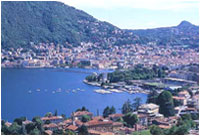 |
The Silk Trail: famous for its products and for creating its own design, it offers the possibility to visit 2 museums, one for silk and the mulberry silkworm-breeding centre.
Funicular to Brunate: from Como town it is possible to take the funicular to the town of Brunate in just seven minutes. Walks in the countryside leave Brunate from where it is possible to enjoy the stunning panorama with its rooftop view of the towns of Lake Como.
Lakeside trail: |
|
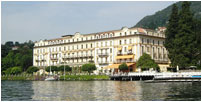 |
Cernobbio: visitors can see Villa Erba, Villa Visconti, Villa D’Este, Villa Fontanella and Villa Passalacqua. A characteristic trail allows visitors to take in old bridges and panoramic views. Sights include Laglio (George Clooney’s villa), Argegno with its pathway to the Sant’Anna Sanctuary (seventeenth century) and a donkey trail that is studded with small religious shrines. Alternatively it is possible to take the cable car to Pigra with its breathtaking view. |
|
- Comacina Island: a trip to the only island on the lake is a must. Called “Zoca de l’Oil” because the climate is so mild that olives can grow there, the island is now uninhabited but a restaurant keeps the traditions and legends of the island alive.
- Path through the Larian Mountains: a hiking trail that links Cernobbio with all the villages dotted along the mountains on the western shores of Lake Como. Various mountain refuges and hotels are located along the 125 Km trail, where hikers can spend the night and have a meal.
- Tremezzo: visit to Villa Carlotta and Villa Collina, the summer residence of chancellor Adenauer.
- Menaggio: è considered a metropolis at the heart of the lake.
|
 |
Bellagio: the “pearl of Lake Como”.
The Church of San Giacomo and Villa Serbelloni are worth seeing along with the Museum of Navigation Instruments. |
|
Day 4: visit to the city of Bergamo.
Bergamo Alta
|
- Piazza Vecchia: the symbol of the city. Already established in the fourteenth century, the southern side is dominated by Palazzo della Regione whilst the civic tower known as “Il Campanone” soars up to the right. The northernmost side of the square is closed in by a seventeenth-century building with a white marble façade. Built to house the Municipality, it currently houses the “A. Mal” Civic Library which boasts around half a million volumes, and is home to a priceless collection of works by sixteenth-century writers Bernardo Tasso and his son Torquato. The square also finds a fountain donated by the Venetian Podestà Alvise Contarini.
- Basilica of Santa Maria Maggiore: Situated in the heart of the city, it is considered Bergamo’s most important monument. Its very location in the centre of the town reveals the importance of this place of worship. Built in the thirteenth century as an offering to the Virgin Mary, the outside of the Basilica has maintained its original Romanesque structure. Originally featuring a Greek cross layout, the sumptuous interiors were modified in the sixteenth and seventeenth centuries.
|
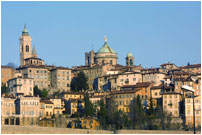 |
|
- Colleoni Chapel: built in 1472 when Bartolomeo Colleoni, a once-famous condottiere in the pay of the Venetian Republic and the General Captain of the Venetian army, decided to build his own mausoleum here. Having overcome the resistance put up by the canons of the basilica, Colleoni had his soldiers demolish the sacristy of S. Maria Maggiore and work got underway. A cultured and progressive man, Colleoni designed a monument which, located in the heart of the city, would create new perspectives. The project was placed in the hands of Giovanni Antonio Amadeo, a sculptor and architect involved in works on building the enormous Charterhouse of Pavia. Yet the task was to reveal itself a complex one: it was necessary to build a construction for housing the remains of the Captain himself whilst also being suitable for celebrating the divine offices, and which would also be in keeping with the basilica alongside it.
- The Venetian walls: the walls of the “Città Alta” or Old Town existed in Roman times, and were rebuilt in the course of the Middle Ages only to be renovated and modified many times in the years that followed. In the early sixteenth century, the walls were in great disrepair. In 1556 the Senate of the Republic of Venice, which had had political and territorial control of Bergamo for over a century, decided to build the city’s fortification walls from scratch.
- Church of San Bernardino: dates back to 1450. It was made a national monument of historical and artistic importance and is considered a keystone of Lombard mannerism.
- The Fortress: a fortress which lies on the hill of Sant’Eufemia; dating back to 1331 it played a key role in the defence and prestige of the city.
Sotto il Monte
Religious and cultural tour: covers the places where Pope Giovanni XXIII was born and lived. Inside the town is Cascina Palazzo, where the pontiff was born, and Cascina Colombera, where the pontiff actually lived. The route takes in the Church of San Giovanni Battista, the stately villa of Cà Martino, the Tower of S. Giovanni and the Sant’Egidio Abbey.
Day 5: Visit to the city of Milan.
|
Duomo: the church that symbolises the city. Dedicated to Santa Maria Nascente, its construction was ordered by Gian Galeazzo Visconti, and it lies on the site of the basilica of Santa Maria Maggiore which was built in the Middle Ages. Built entirely using Candoglia marble, work got underway in 1386. The imposing structure, the sculpted decorations and the stunning stained glass windows make it a fascinating construction. It is the most important evidence in Italy today of international Gothic architecture, and the blend of Nordic features and Lombard elements is unique and unmistakeable. The façade houses classic design windows whilst the coping is in Neo-Gothic style. Inside, the area of the presbytery is of particular interest. Outside, the imposing structure is capped off by the main spire, with its famous Madonnina, a statue gold-plated copper 4 metres high which was made in 1774. On clear days, visitors climbing up to the terraces can enjoy views over the city and the Alps.
La Scala Theatre: Destroyed by fire in 1775. The box-holders’ society and the Court of Vienna decided to build it elsewhere, larger and in brick, demolishing the fourteenth-century church of Santa Maria della Scala. In 1776 – 78 Piermarini created a canonical horseshoe-shaped theatre with six rows of circles for boxes and the gallery; in addition to guaranteeing excellent acoustics, the wooden vaulted ceiling suspended from timber trusses concealed an anti-fire water tank. The interiors were overhauled on various occasions, and in 1906 Arturo Toscanini had the orchestra pit built.
Palazzo Marino: the name comes from Genoese banker Tommaso Marino, who had it built by Galeazzo Alessi between 1553 and 1558. The courtyard is sumptuously decorated with statues, festoons and trophies. On the ground floor is “Sala dell’Alessi” with its painted decorations and stuccos. It was largely restored after the Second World War. The building currently houses Milan City Council. |
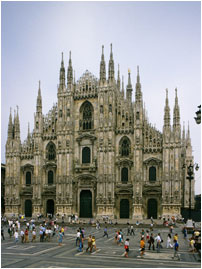 |
|
Galleria Vittorio Emanuele II: By definition it is “La Galleria”, “Milan’s sitting room”. The construction itself is the work of architects Giuseppe Mengoni. Set out in a cross-shape, its wings cross over in an octagon made of iron and glass. From north to south it measures 196 metres, whilst from east to west it measures 105.5 metres. The Galleria is home to restaurants, bars, cafes, bookshops and clothes shops that draw in Milan’s inhabitants and tourists alike.
Castello Sforzesco: Built from 1450 – 66 by Francesco Sforza as a fortress and residence on the area of the dismantled Visconti fortification, the Castle appears in the guise given it by the restoration work Beltrami carried out on it when he saved it from demolition. The imposing Filarete tower was reconstructed thanks to him. The famous Piazza D’Armi is home to the ruins of ancient constructions. Two other towers are defining features of the structure. Today the Castle houses the Civic Collections of Ancient Art, Applied Art and engravings with ceramics, ivory, bronzes, tapestries, musical instruments, stamps and philately as well as the Trivulzian Library.
Church of Santa Maria delle Grazie: Donato Bramante and Leonardo Da Vinci consigned this church to the history of civilisation. Built between 1466 and 1490 to a design by Guiniforte Solari, a few years later the apse was rebuilt. The Cloister and Old Sacristy were added later. In the refectory of the old Dominican refectory, Da Vinci was to pain the renowned “Last Supper” on one of its walls. He started it in 1494 and finished work two years later. Da Vinci painted using a dry-wall technique using a special tempera.
Palazzo di Brera: started in 1651 by Richini, work on this imposing building finished in 1773. Piermarini added a colossal doorway. In the centre of the rectangular courtyard, with its double row of arches on twin columns, is the bronze statue of Napoleon I by Antonio Canova. The building is now home to the Brera Picture Gallery, the Academy of Fine Arts, the Braidense National Library and the Astronomical Observatory.
Leonardo Da Vinci National Museum of Science and Technology: Established in 1953, today it is the largest Italian science and technology museum, where visitors can explore collections dedicated to materials, energy, transport, the borderline area between art and science, and the new frontiers in science and technology, not to mention sciences for children.
Milan for shopping and art: Milan is the city of fashion. This type of tour is suitable for everyone, and shopping and culture take centre stage. The fashion quarter is a magical area in which the dreamlike creations proposed on all the very greatest catwalks come to life. On this junction of streets, between one shop and another, some of the city’s most representative and often-visited monuments also find room. They include:
- The Fashion Quarter, one of the most refined in the city, both in terms of the shopping and the architecture, with its neoclassical buildings.
- Piazza Duomo: the neuralgic heart of the city. A short distance away lies Corso Vittorio Emanuele II, a pedestrian area brought to life by bars, cinemas, bookshops and clothes shops.
- Piazza San Babila: the ancient church by the same name is worth visiting. The square also finds the Teatro Nuovo theatre and Teatro San Babila theatre.
Day 6– Trips on the lake by motorboat or private speed boat.
Itinerary 1: Bellagio. Departure from the dock at Lecco. Coasts the northernmost shores of Lario with its characteristic villages. On arriving in Bellagio visitors disembark to visit the village’s narrow streets and steep stairways. The sailing tour continues in front of Villa Melzi and Villa Serbelloni with its colourful gardens. The tour lasts around 3 hours, of which 1 and a half hours are for the break at Bellagio.
Itinerary 2: Manzoni Tour. Departure from the dock at Lecco. Offers a tour of the places that inspired Manzoni and some of the key locations in his novel “The Betrothed”. The tour takes in the statue of San Nicolò, the Fortress overhanging the lake at Malgrate, the River Adda, Garlate Lake, Pescarenico, the fluvial island of Lecco and the three bridges. The tour lasts around 45 minutes.
Itinerary 3: Thee bridges and centre of the lake. Departure from the dock at Lecco. Tour of the villages along the water’s edge along the middle of the eastern shores. The tour takes in Mandello, Abbadia, Onno, the River Adda, Lake Garlate, Pescarenico, the fluvial island and the Azzoni Visconti Bridge. The tour lasts around 70 minutes.
Itinerary 4: Varenna, the pearl of Lario. Departure from the dock at Lecco. The tour reaches Varenna by sailing alongside the villages on the shore, Fiume Latte, Villa Cipressi and Villa Monastero, with all their colourful gardens, and the ruins of Vezio Castle. On reaching Varenna visitors can disembark to visit the village and walk along the well-known “Lovers’ Path”. On the return journey the route takes in the shores of Bellagio, Pescallo, Oliveto Lario, Vassena, Parè and Malgrate. The tour lasts around 3 hours, of which 1 and a half hours are for the break at Varenna.
|
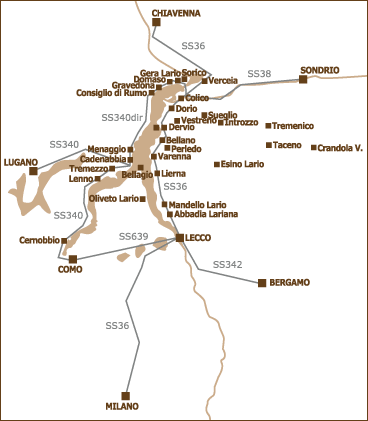
|
Docking for hire of private speedboats
- Lungolario Isonzo, Lecco
- Rivagrande, Varenna
Distances from Montevecchia in kilometres.
Montevecchia – Lecco: km 27
Lecco – Colico: km 30
Montevecchia – Como: km 30
Como – Domaso: km 40
Montevecchia – Bergamo: km 30
Montevecchia – Milan: km 30 |
|
|
